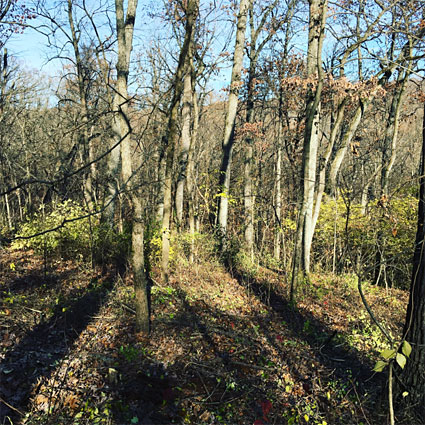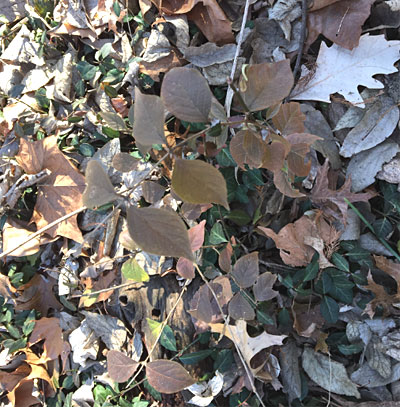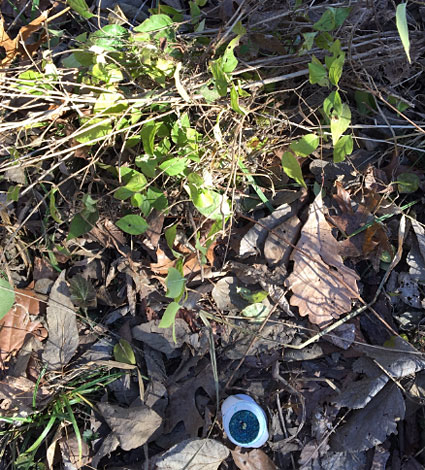“Is that a weed?”
by Carolyn Hasenfratz Winkelmann
A client asked me that question once while we were looking at a wild spot in her yard that she wanted to convert into a garden. We were brainstorming and I was trying to get an idea of what style of garden the client might want. She asked me if a tall yellow-flowering wildflower prominent in the proposed new garden spot was a weed. A weed is a plant where you don’t want it, not a particular species, so that isn’t always an easy question to answer. In certain styles of garden that plant would have been a weed, in others it would have been appropriate. So I told her in so many words, “You get to decide whether it’s a weed or not. It may or may not look good in your new garden depending on the style”. It would have been lovely for example in a wildflower meadow or bird garden but problematic as part of a garden that depends on a manicured look.
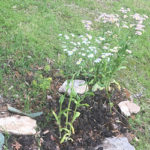 I volunteer at Litzinger Road Ecology Center and even though they specialize in growing native wildflowers, they had too much Fleabane on the patio where they didn’t want it, so in that particular spot it was a weed. I moved some to my new rock garden and I think it looks very appropriate there. It should look even better when this rock garden gets a chance to fill in a little. My husband Tom even complimented me on this plant completely unprompted! As this rock garden expands, I’m planning on planting around the tufts of moss that grow on this slope rather than removing them. I love moss and I want it in my rock garden. When this area was formerly supposed to be turf grass, moss was a problem.
I volunteer at Litzinger Road Ecology Center and even though they specialize in growing native wildflowers, they had too much Fleabane on the patio where they didn’t want it, so in that particular spot it was a weed. I moved some to my new rock garden and I think it looks very appropriate there. It should look even better when this rock garden gets a chance to fill in a little. My husband Tom even complimented me on this plant completely unprompted! As this rock garden expands, I’m planning on planting around the tufts of moss that grow on this slope rather than removing them. I love moss and I want it in my rock garden. When this area was formerly supposed to be turf grass, moss was a problem.
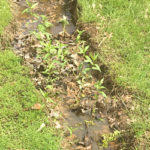 Some plants have “weed” in the name which gives you a clue about how it is sometimes regarded. This Swamp Milkweed that I just planted in part of our new rain garden could get “weedy” because it reproduces like crazy at my condo, which is where I obtained these transplants. There are many more still to bring over! These get to be large plants and when I run out of space they might become “weeds”. For now, they are a critical part of my landscape plan and I’m overjoyed to see lots of seedlings. I can welcome many more before there are too many. I’m going to try to grow multiple milkweed species because they provide critical Monarch caterpillar food.
Some plants have “weed” in the name which gives you a clue about how it is sometimes regarded. This Swamp Milkweed that I just planted in part of our new rain garden could get “weedy” because it reproduces like crazy at my condo, which is where I obtained these transplants. There are many more still to bring over! These get to be large plants and when I run out of space they might become “weeds”. For now, they are a critical part of my landscape plan and I’m overjoyed to see lots of seedlings. I can welcome many more before there are too many. I’m going to try to grow multiple milkweed species because they provide critical Monarch caterpillar food.
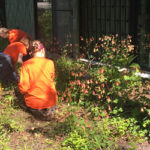 Pokeweed is another plant with weed in the name that can get “weedy”. In a wildflower garden you might want to leave one or two. It is native to Missouri and provides bird food. It is also quite pretty. I’m used to getting rid of it entirely on client sites but when weeding a wildflower garden at Litzinger Road Ecology Center the other day I asked first about each plant before removing it because I know the purposes of gardens there are much different than on most client sites. I was asked to leave one Poke plant in this case (it’s behind the native Columbine). That’s exactly what I recommended a few years ago for my Dad’s garden which was designed as a wildflower garden that is friendly to birds and pollinators. A few Poke plants are nice in a wildflower garden but too many could be a problem because they really spread a lot.
Pokeweed is another plant with weed in the name that can get “weedy”. In a wildflower garden you might want to leave one or two. It is native to Missouri and provides bird food. It is also quite pretty. I’m used to getting rid of it entirely on client sites but when weeding a wildflower garden at Litzinger Road Ecology Center the other day I asked first about each plant before removing it because I know the purposes of gardens there are much different than on most client sites. I was asked to leave one Poke plant in this case (it’s behind the native Columbine). That’s exactly what I recommended a few years ago for my Dad’s garden which was designed as a wildflower garden that is friendly to birds and pollinators. A few Poke plants are nice in a wildflower garden but too many could be a problem because they really spread a lot.
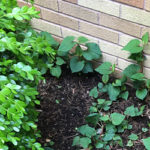 My mother-in-law has Wild Ginger that she considers weedy because her garden style doesn’t call for continuous ground cover. We associate Boxwood as shown at left of this picture with manicured garden styles so when we see it with something that looks wild or naturalized it just looks overgrown to our eye, not harmonious. My gardens are very informal though, and I’ve been digging some of this up to replace at least some of the Vinca minor at my condo. Wild Ginger is native and Vinca minor is invasive, so I’d much rather have the Wild Ginger. My mother-in-law is finding it hard to believe I want this but I’m really delighted to have it – it’s been on my wish list for years! In the right garden this could be beautiful – in the wrong one, a major maintenance headache. At one time I deliberately planted the Vinca minor because I love the flowers and it took me years to get it established, but now I have too much and it has passed into “weediness” for me.
My mother-in-law has Wild Ginger that she considers weedy because her garden style doesn’t call for continuous ground cover. We associate Boxwood as shown at left of this picture with manicured garden styles so when we see it with something that looks wild or naturalized it just looks overgrown to our eye, not harmonious. My gardens are very informal though, and I’ve been digging some of this up to replace at least some of the Vinca minor at my condo. Wild Ginger is native and Vinca minor is invasive, so I’d much rather have the Wild Ginger. My mother-in-law is finding it hard to believe I want this but I’m really delighted to have it – it’s been on my wish list for years! In the right garden this could be beautiful – in the wrong one, a major maintenance headache. At one time I deliberately planted the Vinca minor because I love the flowers and it took me years to get it established, but now I have too much and it has passed into “weediness” for me.
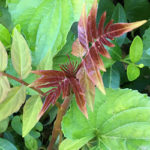 This reddish seedling came up in the garden at the condo. I like to find out what a volunteer plant is before I pull it if at all possible in case it could be interesting or useful to grow somewhere. I showed the photo to the folks at Litzinger Road Ecology Center and they said it was an invasive Tree of Heaven and to destroy it! I was hoping it was a native Sumac that I could move to our house but sadly not, it has to go.
This reddish seedling came up in the garden at the condo. I like to find out what a volunteer plant is before I pull it if at all possible in case it could be interesting or useful to grow somewhere. I showed the photo to the folks at Litzinger Road Ecology Center and they said it was an invasive Tree of Heaven and to destroy it! I was hoping it was a native Sumac that I could move to our house but sadly not, it has to go.
The Importance of Plant Identification
I wrote about the previous examples of how I’m dealing with “weeds” so that you can get ideas for how to treat any volunteer plants that you didn’t expect or are not sure you want to keep. It is necessary to identify the plants so that you can get information to make an informed decision. I need to write more about plant identification but in the meantime this previous article I wrote for Schnarr’s has some identification tips in it that could help: How to Diagnose Plant Problems.
Here is a Pinterest board I started to help identify, treat and prevent weeds: Weeds
Here are some applications that can help you out with identifying plants:
